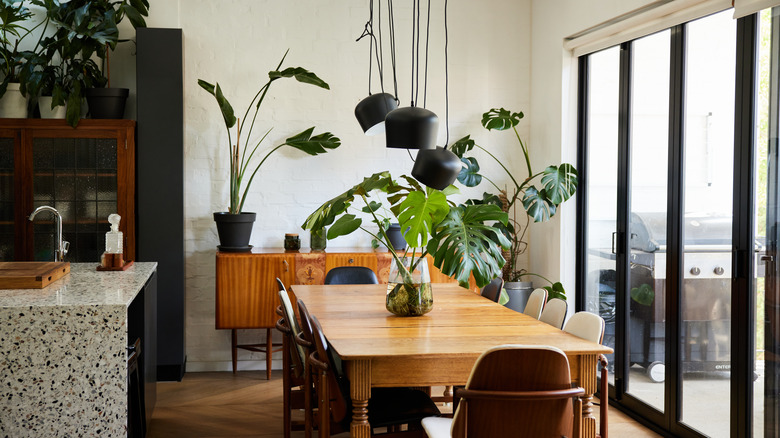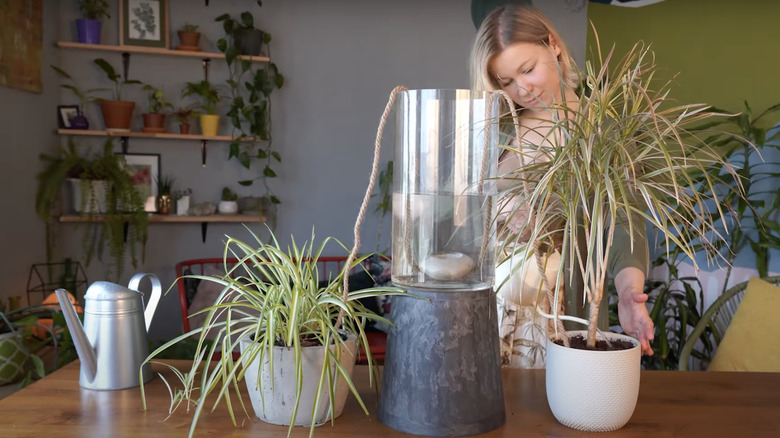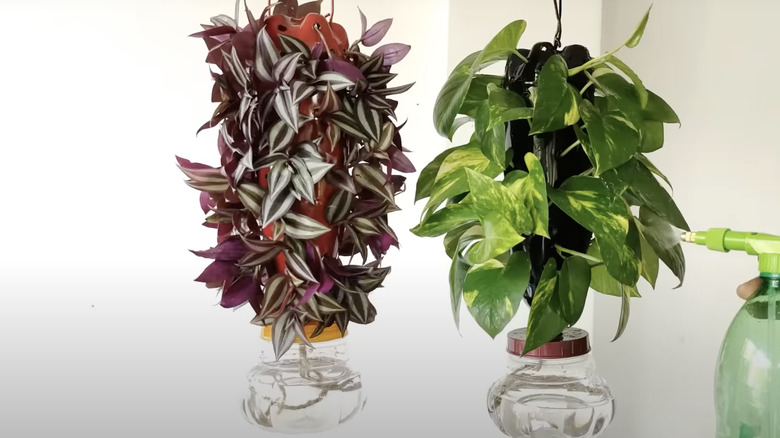The Hack That'll Keep All Of Your Indoor Plants Alive While You're On Vacation
Going on vacation gives you a small break from reality. You don't have to worry about cleaning the house, going to work, or taking the kids to school. Instead, you enjoy exploring a new area you've never been to before or visiting friends and family you haven't seen in a while. Although you're going away to relax, a few things will still need caring.
For example, if you have houseplants that are your pride and joy, they'll need watering. Houseplants — even those that anyone can keep alive — quickly die without being watered at their usual times. There are different ways to water your plants, but using a wick connected from a water jug to the plant will keep the plant watered while you're away. You won't have to ask a friend for a favor of watering your plants — they'll simply water themselves.
All indoor plants require a different amount of water. When using the wicking system, each plant will absorb only as much as they need to keep themselves hydrated. They'll have enough water instead of sitting in too much water where they could get wet feet and rot. All of your indoor plants will stay hydrated and alive. The wick system hack is excellent to use even when you're not on vacation, so it works for those who have always wanted a houseplant but don't have a green thumb.
Create your wick system with string and water
Whether you're going on vacation and need your houseplants watered, or you've always wanted your house filled with plants but don't have the greenest thumb, creating a self-watering plant system will keep your plant babies healthy, hydrated, and alive. You'll need plants, paper clips, cotton string, scissors, a short stool, and a pot.
First, place all of your plants in one area, ideally sitting in a row next to each other by a window. Next, measure and cut 2 feet of the cotton string. Cut as many strings as you need for each of your plants. For example, if you have five plants, you'll need five separate pieces of string. Then, tie one paper clip to the end of one string, and repeat for the other strings. After tying the paper clips, fill your pot halfway with water and place it on top of the short stool next to the plants.
Stick the paper clip end into the water bowl to weigh down the string. Dig 1 to 2 inches into the plant's soil and insert the other end of the string inside, covering it with soil to keep it in place. Finally, ensure all of the strings are in a straight slope down from the pot to the soil so that the water travels to the plant. The water won't make it to the soil when there's a bend or dip in the string.
Why the wick system works
If you're using the wick watering system for the first time but don't how why it works so well, it's simple. Gravity helps the water travel from the water bowl to the plants through the wettable fabric. The most common fabric folks use when following the wick system is cotton — if you don't have cotton string, you can cut a cotton t-shirt into thin strings, which work the same. The hack we mentioned is the capillary method, where you place the string in the bowl and the soil. It works perfectly for larger plants, especially with multiple plants at home.
However, if you only have small plants, another ideal self-watering method involves water traveling upwards toward the plant. Essentially you fill a small plastic cup with water, place the cotton string inside your small plant through the bottom, then place it in the cup, where the string is in the water, and the plant is resting just above it.
This method works perfectly for plants you're starting to grow and water. You won't have to worry about watering them when necessary since they'll always stay moist and watered by the wick. You can see this self-watering system in the image above, except here the plants are being grown in plastic soda bottles.


